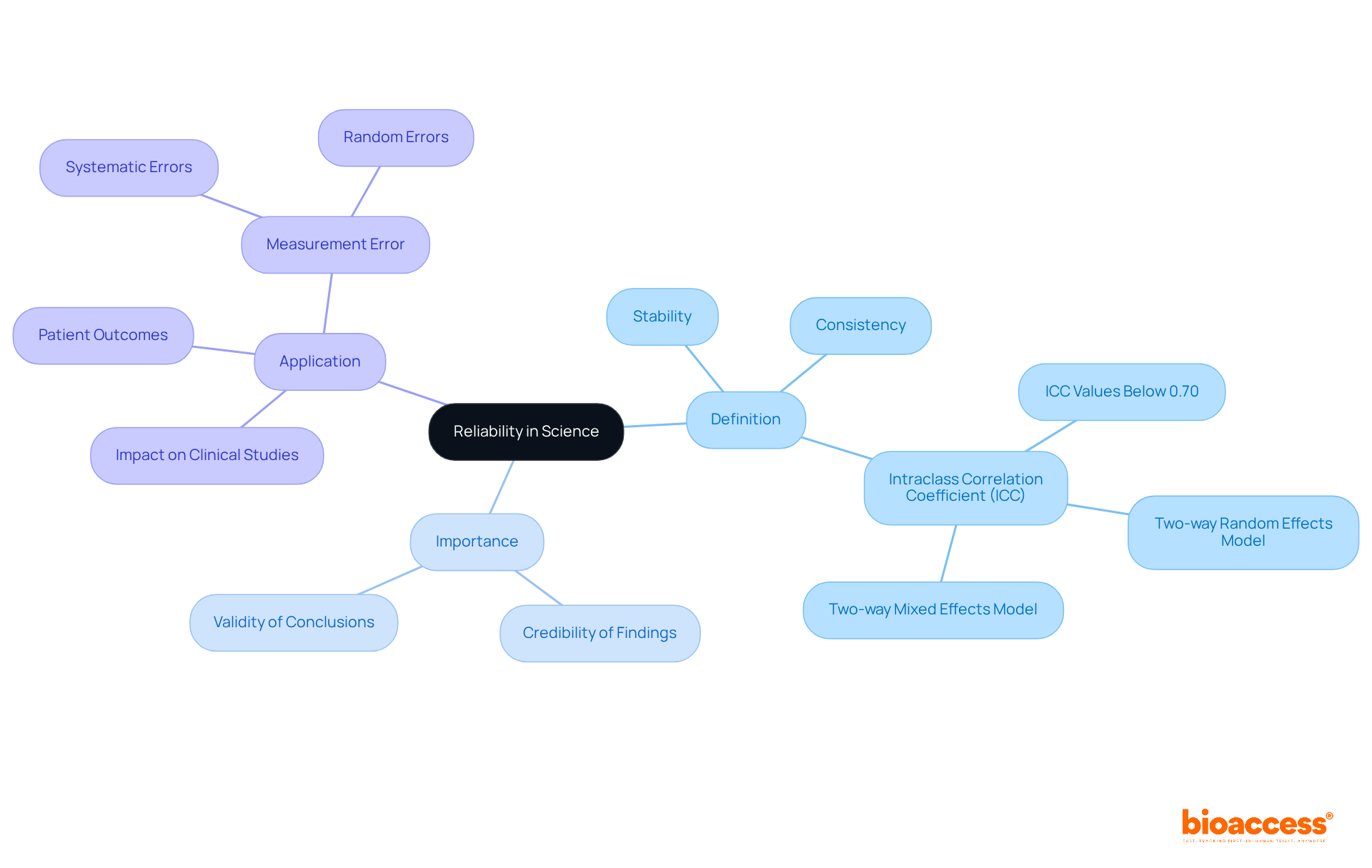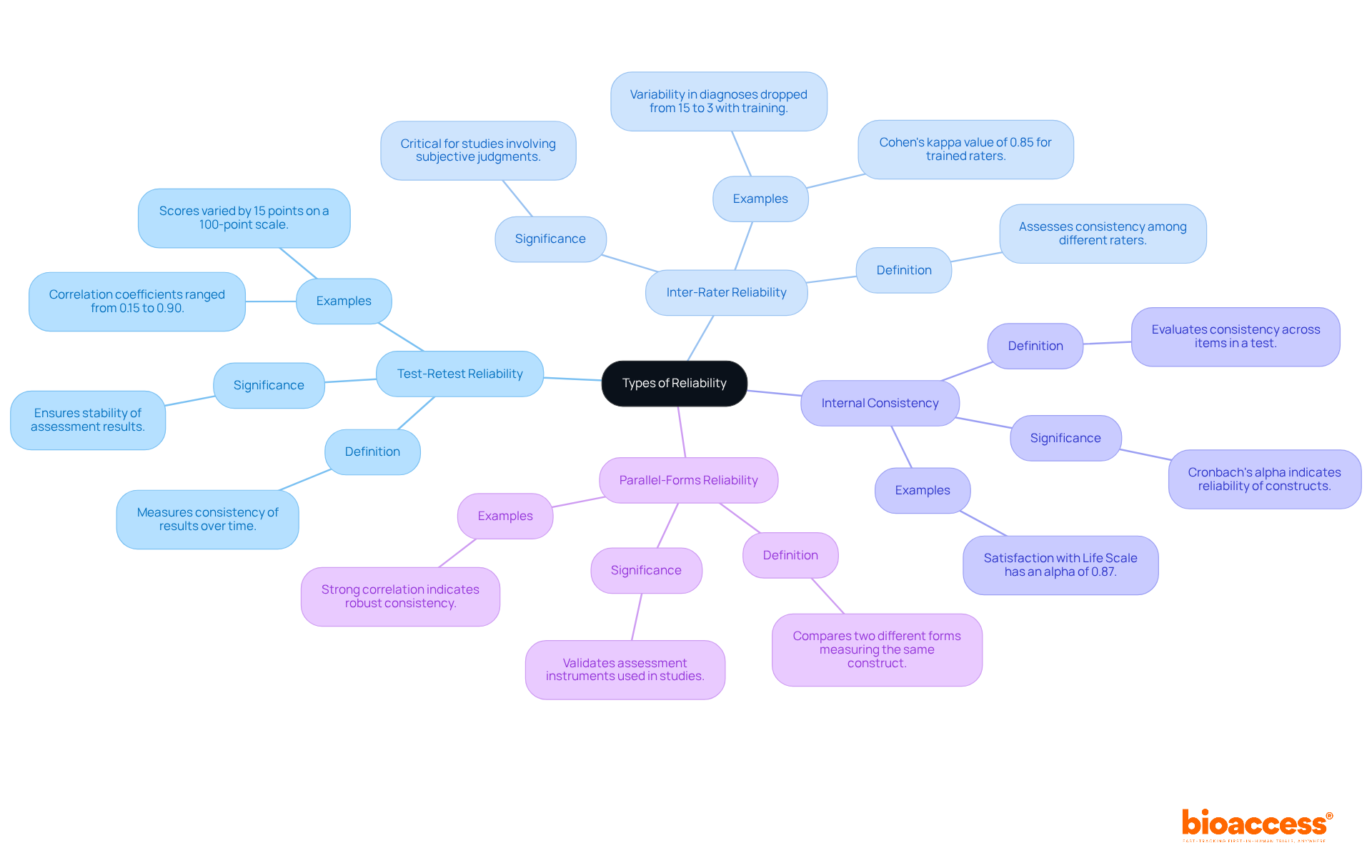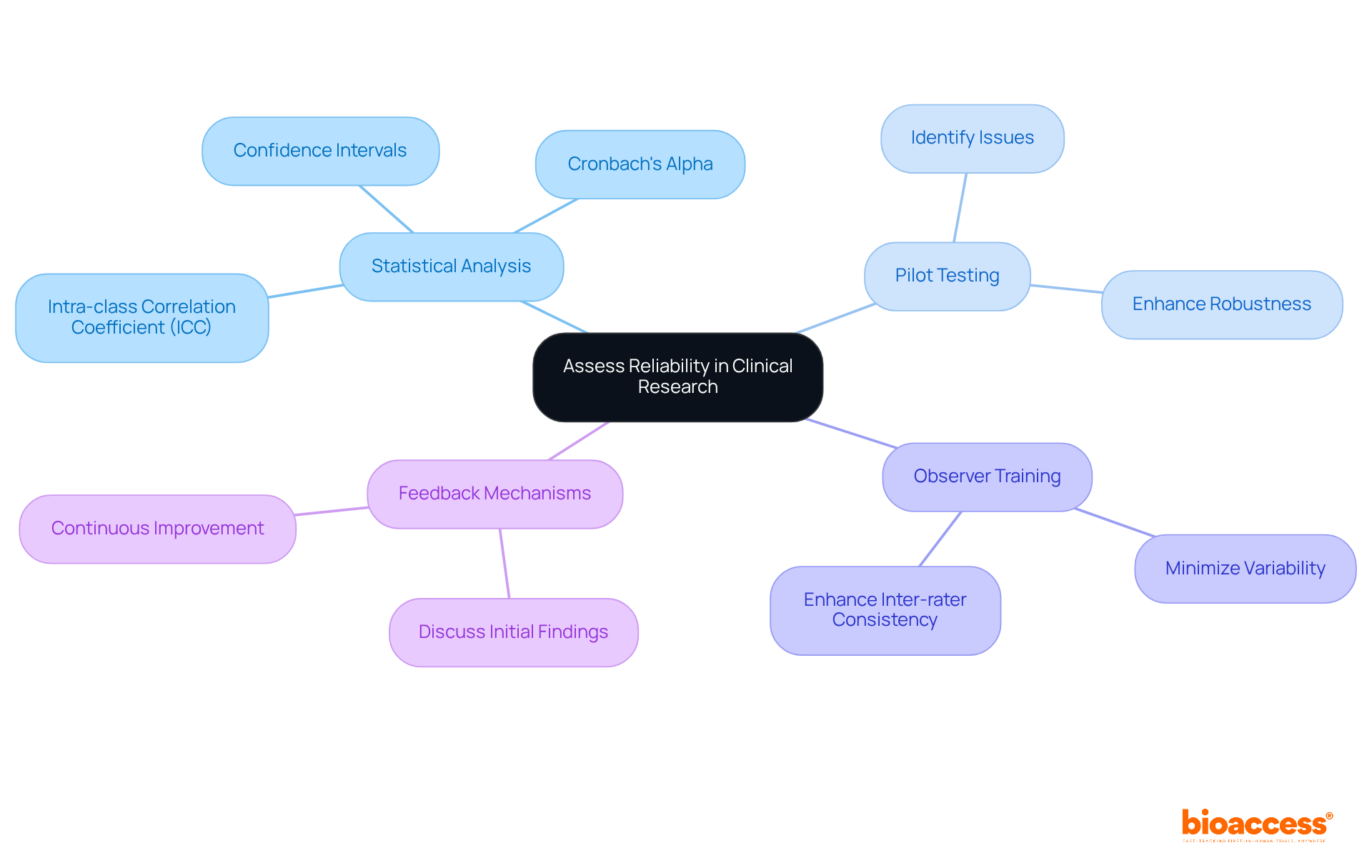


Reliability in science is fundamentally defined as the consistency of a measurement. This consistency ensures that results can be reproduced under similar conditions, which is crucial for establishing credible research findings. Understanding various types of reliability—such as test-retest, inter-rater, and internal consistency—is essential for researchers aiming to enhance the trustworthiness of their outcomes.
Moreover, implementing strategies like standardization and training significantly bolsters the reliability of research. These approaches not only improve measurement consistency but also foster a culture of rigor within research teams. By prioritizing reliability, researchers can produce findings that stand up to scrutiny and contribute meaningfully to the scientific community.
In conclusion, the emphasis on reliability in scientific research cannot be overstated. It is a cornerstone of credible research that demands attention and action from all involved in clinical studies. By investing in understanding and applying reliable measurement techniques, researchers can ensure their work is both trustworthy and impactful.
Understanding reliability in science is crucial for researchers who strive to produce credible and reproducible findings. This article delves into the intricacies of measurement consistency, illuminating essential steps that can significantly enhance the quality of scientific research. With various types of reliability and assessment methods available, researchers face the challenge of navigating these complexities. How can they ensure their studies yield trustworthy results?
By addressing these questions, we aim to provide insights that not only clarify the concept of reliability but also emphasize its relevance in the broader context of clinical research. In an ever-evolving Medtech landscape, understanding reliability is more than just a theoretical exercise; it is a vital component in overcoming key challenges faced by researchers today.
To define reliability in science, it is crucial to understand that it pertains to the consistency of a measurement or the extent to which an instrument yields the same outcomes upon repeated trials. This concept is essential for ensuring that study findings are both reliable and reproducible. To grasp the importance of reliability, consider the following:
Definition: Reliability indicates how well research results can be reproduced under similar conditions. To define reliability in science, high dependability signifies that results remain stable and consistent over time. The intraclass correlation coefficient (ICC) is often used to quantify this reliability, with values below 0.70 suggesting a need for improvement in assessment tools.
Importance: To define reliability in science, trustworthy investigation is vital for establishing a solid foundation of knowledge in any scientific field. It enhances the credibility of findings and supports the validity of conclusions drawn from the data. As Lidwine B Mokkink states, "Reliability and assessment error are assessment properties that quantify the influence of specific sources of variation on the score of the individual evaluation."
Application: In clinical studies, for instance, dependable assessments can significantly impact patient outcomes and treatment effectiveness. Ensuring reliability aids in making informed decisions based on research data. Consistent evaluation of clinical parameters guarantees that healthcare decisions are grounded in accurate information, ultimately enhancing patient care. Furthermore, understanding measurement error—systematic and random inaccuracies not linked to actual changes—is essential for interpreting the consistency of measurements.
By understanding how to define reliability in science, researchers can better appreciate the importance of subsequent steps in enhancing their research quality. Pre-registering studies and addressing potential rater variability are also critical for improving consistency and ensuring that findings are robust and applicable.

Researchers must understand several types of reliability to ensure the credibility of their findings:
Test-Retest Reliability: This type measures the consistency of results when the same test is administered to the same subjects at different times. A significant correlation between the two sets of findings suggests strong test-retest consistency. For instance, a study revealed that test-retest consistency coefficients can vary widely, ranging from 0.15 to 0.90. This highlights the importance of precise administration and timing to achieve dependable outcomes.
Inter-Rater Reliability: This assesses how consistently different raters or observers estimate the same phenomenon. It’s particularly crucial in studies involving subjective judgments. For example, in a clinical trial evaluating patient responses, the variability in diagnoses among radiologists dropped from 15% to just 3% after implementing standardized training and clear guidelines. As Alexandre Bonnet emphasizes, the significance of inter-rater consistency cannot be overstated, especially when observer agreement is vital to the study's validity.
Internal Consistency: This evaluates the consistency of results across items within a test, commonly measured using Cronbach's alpha. A score of 0.70 or higher typically indicates good internal consistency, ensuring that the items effectively measure the same construct.
Parallel-Forms Reliability: This involves comparing two different forms of a test that measure the same underlying construct. A strong correlation between the two forms indicates robust parallel-forms consistency, which is essential for validating the assessment instruments used in studies.
Understanding these categories of consistency is essential for researchers to define reliability in science, allowing them to select the most suitable methods for their studies and ensuring that their findings are robust and trustworthy. Experts stress that rigorous training and comprehensive guidelines for raters are essential to uphold the integrity of research findings.

In clinical research, it is crucial to assess how we define reliability in science, and researchers can employ several established methods to ensure their instruments yield trustworthy results.
Statistical Analysis: Researchers should utilize statistical tools to calculate reliability coefficients, such as the Intra-class Correlation Coefficient (ICC) for continuous variables or Cronbach's alpha for internal consistency. These coefficients produce numerical values that signify the trustworthiness of the measuring device. Notably, the ICC is the most commonly used method, appearing in 60% of reviewed studies, although only 28% reported confidence intervals, which are essential for accurate interpretation.
Pilot Testing: Conducting pilot studies is another effective strategy to assess the consistency of research instruments before full-scale implementation. This approach allows researchers to identify potential issues and make necessary adjustments based on initial findings, ultimately enhancing the robustness of the study.
Observer Training: In studies involving multiple raters, comprehensive training for all observers is essential to minimize variability in assessments. This practice significantly enhances inter-rater consistency, ensuring that measurements are uniform across various evaluators.
Feedback Mechanisms: Establishing feedback loops where researchers can discuss initial findings and enhance their measures based on peer input is vital. This collaborative approach fosters continuous improvement and helps identify any inconsistencies in the data collection process.
By systematically applying these methods, researchers can effectively evaluate and improve the consistency of their instruments, which is essential to define reliability in science, leading to more trustworthy and valid results in clinical trials.

To enhance the reliability of your research, consider implementing the following strategies:
Standardize Procedures: Develop and adhere to standardized protocols for data collection and analysis. Consistency in procedures reduces variability and improves dependability. Research shows that adopting standardized methods can lead to significantly enhanced uniformity in research outcomes, promoting confidence in conclusions. Notably, studies with strong consistency are more likely to secure successful regulatory approvals, with over 70% of dependable experiments achieving favorable outcomes.
Increase Sample Size: A larger sample size can bolster the trustworthiness of findings by minimizing the impact of outliers and random error. As sample size increases, effect estimates stabilize while confidence intervals narrow, enhancing the precision of results. A well-powered study, defined as having a power of 80% or greater, is crucial for accurately detecting true effects.
Use Reliable Instruments: Choose assessment tools that have been validated for reliability in previous research. Utilizing established assessment tools ensures consistent and accurate results, which is essential for drawing important conclusions.
Regular Training: Provide ongoing training for researchers and data collectors to ensure familiarity with protocols and measurement tools, thereby reducing variability in data collection. Extensive training initiatives have shown a substantial improvement in the overall dependability of findings. Investing in training for all personnel involved in clinical trials is vital for minimizing errors and enhancing data quality.
Conduct Regular Reviews: Periodically assess and refine your investigative methods and tools based on feedback and findings from prior studies. This repetitive process enables the identification of potential issues and the implementation of enhancements, further boosting the dependability of your study.
By adopting these strategies, researchers can significantly define reliability in science, which will lead to more credible and impactful research outcomes.

Understanding and defining reliability in science is crucial for researchers who aim to produce credible and reproducible findings. This concept not only underscores the consistency of measurements but also serves as the backbone of trustworthy scientific inquiry. By emphasizing the role of reliability, researchers can enhance the validity of their conclusions and ultimately contribute to a solid foundation of knowledge in their respective fields.
The article outlines various types of reliability—test-retest, inter-rater, internal consistency, and parallel-forms reliability—each serving a distinct purpose in ensuring that research findings are dependable. Furthermore, it highlights the importance of established methods for assessing reliability, including:
Implementing strategies such as standardizing procedures, increasing sample sizes, and conducting regular reviews can significantly bolster the reliability of research outcomes.
In the pursuit of scientific excellence, prioritizing reliability is not merely an academic exercise; it is essential for informed decision-making and advancing patient care in clinical settings. Researchers are encouraged to adopt these best practices to enhance the reliability of their studies, ensuring that their contributions to science are both impactful and trustworthy. By doing so, they can foster a culture of rigor and integrity that benefits the entire scientific community.
What is the definition of reliability in science?
Reliability in science refers to the consistency of a measurement or the extent to which an instrument yields the same outcomes upon repeated trials. It indicates how well research results can be reproduced under similar conditions.
Why is reliability important in scientific research?
Reliability is vital for establishing a solid foundation of knowledge in any scientific field. It enhances the credibility of findings and supports the validity of conclusions drawn from the data.
How is reliability quantified in scientific studies?
The intraclass correlation coefficient (ICC) is often used to quantify reliability, with values below 0.70 suggesting a need for improvement in assessment tools.
How does reliability impact clinical studies?
In clinical studies, dependable assessments can significantly impact patient outcomes and treatment effectiveness. Ensuring reliability aids in making informed decisions based on research data, ultimately enhancing patient care.
What types of measurement errors should researchers be aware of?
Researchers should understand measurement error, which includes systematic and random inaccuracies not linked to actual changes, as it is essential for interpreting the consistency of measurements.
What steps can researchers take to improve reliability in their studies?
Researchers can improve reliability by pre-registering studies and addressing potential rater variability, which enhances consistency and ensures that findings are robust and applicable.